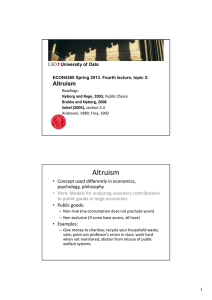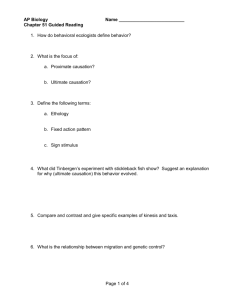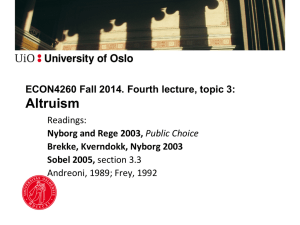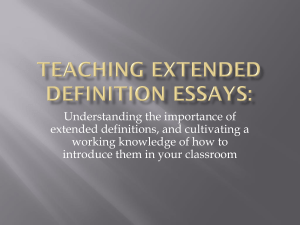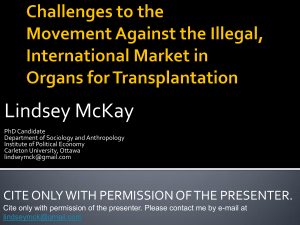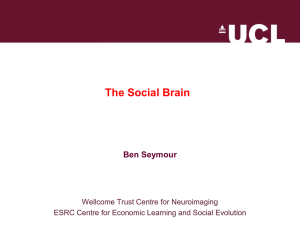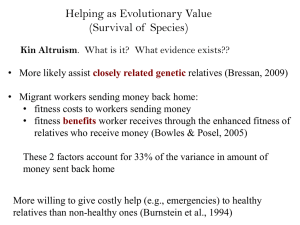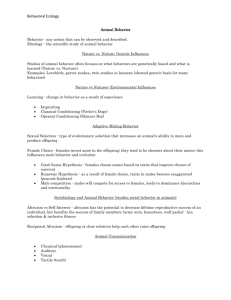Altruism Readings Voluntary contributions to public d i l
advertisement
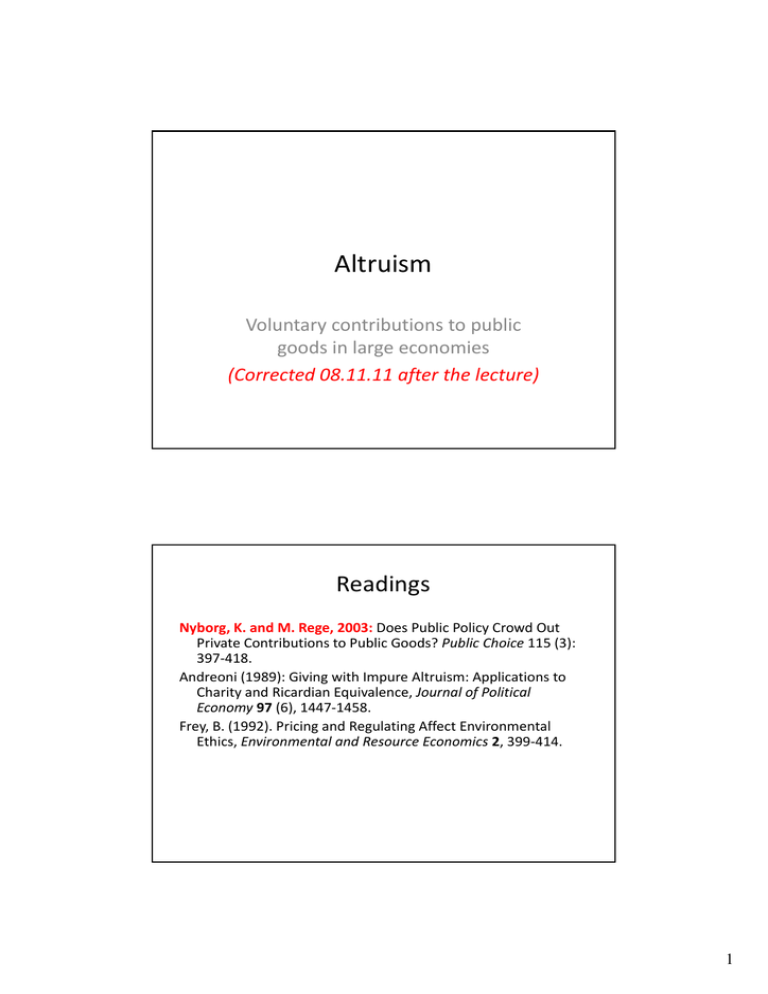
Altruism
Voluntary contributions to public
goods
d in large economies
i l
i
(Corrected 08.11.11 after the lecture)
Readings
Nyborg, K. and M. Rege, 2003: Does Public Policy Crowd Out Private Contributions to Public Goods? Public Choice 115 (3): 397‐418.
Andreoni (1989): Giving with Impure Altruism: Applications to Charity and Ricardian Equivalence, Journal of Political Economy 97 (6), 1447‐1458.
Frey, B. (1992). Pricing and Regulating Affect Environmental Ethics, Environmental and Resource Economics 2, 399‐414.
1
Altruism
• Concept used differently in economics, psychology, philosophy • Homo Oeconomicus: Ui = U(xi, G)
xi is i’s consumption of private goods, G is the supply of a pure public good.
– I care about my own access to private and public goods
• ’Classical’ altruism: Ui = U(xi, G, U‐i)
– I care about others’ utility/happiness
• ’Pure altruism’:
’P
lt i ’
Ui = V(x
V( i, G)
G)
– I care about others’ access to the public good
• ’Impure altruism’: Ui = w(xi, G, gi)
– I care about how much I have contributed myself (gi)
– ’warm glow of giving’: private benefit of own giving
Voluntary contributions
• Examples:
–
–
–
–
–
–
Give money to charities
Recycle your household waste Vote
Point out professor’s errors in class Work hard when not monitored
Abstain from misuse of public welfare systems
• Public goods:
– Non‐rival (my consumption does not preclude yours)
Non rival (my consumption does not preclude yours)
– Non‐exclusive (if some have access, all have)
2
Public good games
• Typical findings:
– One‐shot: Average contributions about 50 % – Decline substantially with repetition
– If players can sanction each other: they do so, even at a cost, and contributions stay high
– Unconditional contributors are rare
– Many conditional contributors
• Possible conclusions: – People are reciprocal, not altruistic?
– Both, but game triggers mainly reciprocity? Market data and field experiments
• Substantial voluntary contributions
• Increase when non‐anonymous
– Social approval/disapproval, social status • Even with anonymity: major contributions
• Contributions increase in (belief about) others’ contributions
3
Motivation
Motives for sorting waste among those who report sorting in the sample. Percent.
Number of respondents = 1102 (excluding those who do not sort at the source).
source)
I sort partly because…
Agree
42
Partly
agree
31
Partly
disagree
8
Disagree Don't
know
18
1
I want to think of myself as a responsible
person
I want others to think of me as a responsible
person
I perceive it as mandated by the authorities
It is a pleasant activity in itself
I should do what I want others to do
I want to contribute to a better environment
22
19
12
46
2
38
16
65
86
25
22
23
11
11
18
5
2
26
44
6
1
1
1
1
1
Source: Bruvoll, Halvorsen, Nyborg (2002)
Homo Oeconomicus
Ui = U(xi, G) (U’x >0, U’G>0, U quasiconcave)
Ex.: Ui = u(xi) + v(G) (u’>0, v’>0, u’’<0, v’’<0)
Cares only about own access to private (xi) and public (G) ) and public (G)
• Cares only about own access to private (x
goods.
• The free‐rider problem : – Each contributes only until his own marginal benefit of consumption equals his own marginal benefit of the public good (G).
– i does not take others’ benefits of G into account
d
k
h ’b
fi f G i
4
Homo Oeconomicus: the free‐rider problem (1)
(2)
(3)
•
•
•
•
Ui = u(xi)+v(G)
Y = x i + g i
G = G0+∑j g j
G = G
(u’ >0, u’’<0, v’>0, v’’<0) Y = exogenous income
(G0 = public sector supply, = public sector supply
j={1,…,N})
0 Let i consider G ‐i = G + ∑j≠i g j exogenous
wrt. gi
Maximizing Ui = u(Y ‐ g i) + v(G ‐i + g i) ∂Ui /∂g i = ‐u’ + v’ = 0 First order condition for interior optimum:
First order condition for interior optimum: u′ = v′
(or u’/v’=1)
Social optimum, Homo Oeconomicus
• Utilitarian social welfare function: (5)W = ∑k U k where k = {1,...,N}
• How much should person i contribute,
p
,
keeping everyone else’s contributions fixed?
Max. W wrt. gi (assume interior solution):
W = ∑k Uk = ∑k [u(Y ‐ g k) + v(G ‐k + g k)] ∂W /∂g i =
∑k [v’] + u’
• First‐order condition for welfare max:
u′ = Nv′
• First order condition for interior optimum: u′ = v′
5
Will i contribute at all?
• If i contributes: less than optimal
• If u’(Yi) > v’(G‐i), i contributes nothing!
• If others contribute more (G‐i higher), i contributes less
• If income differs: The richest (highest Yi) contribute, all others free‐ride
• Increased public supply G0 (lump‐sum financing): Like higher G‐i
Like higher G
– In equilibrium: Crowds out voluntary contributions dollar for dollar (as long as there are voluntary contributions left at all).
Homo Oeconomicus and public goods
Ui = u(xi) + v(G)
identical prefs; u, v concave & incr.
F.o.c.: u’(xi) = v’(G)
At G=G -i (i.e., gi=0): G -i exogenous. Determines v’(G -i).
Y exogenous.
g
Determines u’(Y).
( )
Utility
Ui
Slope:
v’(G*)=
u’(Y)
Slope: v’(G -i)
v(G)
G*: the G level
where i would be
just indifferent
between
contributing and
not contributing
G*
G
G -i
If G* ≤ G -i, i contributes nothing (corner solution).
6
Pure altruism (Andreoni 1988)
Ui = V(xi, G) (V’x >0, V’G>0, V quasiconcave)
• I care about my own income, and my own and others’ access to the public good.
– Example: U
Example: Ui = V(x
V(xi, G)
, G)= u(x
u(xi) ) + v(G)
v(G) + k(G)
where u, v and k are concave and increasing.
• May increase voluntary contributions, but does not solve the free‐rider problem.
– Pure altruism corresponds formally to the Homo Oeconomicus case
– kk’ > 0 corresponds to a stronger preference for G
> 0 corresponds to a stronger preference for G
– Still: If income differs, only the richest contribute
– Still: Full crowding out in equilibrium
Pure altruism and public goods
Ui
= u(xi) + v(G) + k(G)
= u(Y - gi) + v(G -i + gi) + k(G -i + gi)
u, v, k concave & incr., identical prefs.
At G=G -i (gi=0): v’ and u’ determined by G -i and Y
Slope: u’(Y)
Slope: v’(G -i)+k’(G -i)
v(G) + k(G)
Slope: v’(G -i)
v(G)
G
G -i
If v’(G -i )+k(G -i ) < u’(Y), i contributes nothing
The richer i, the lower u’(Y) -> only the richest contribute
7
Pure altruism: the free‐rider problem
• Utilitarian social welfare function: W = ∑i U i
• Homo Oec: Ui = U(xi, G) = u(xi) + v(G)
– Individual utility max. (interior): u′ = v′
– Max. W (interior): u′ = Nv′
• Pure altruism: Ui = V(xi, G)= u(xi) + v(G) + k(G)
– Individual utility max. (interior): u′ = v′ + k′
– Max. W (interior): u′ = N(v′ + k′)
• If k′ > 0, socially optimal G higher than for HOe
– Altruistic benefit k′(G) counts in W, just like v′(G). – Larger G: more altruistic benefits, more use benefits.
• Still: Own supply decreasing in others’ supply
– altruistic benefits are motivated by total supply, regardless of who provided it. Pure altruism, conclusions
• Unsatisfactory as explanation of voluntary contributions to public goods
t ib ti
t
bli
d
– Cannot explain substantial contributions by a substantial number of people
– Predicts: i’s contribution decreases in the contributions of others. Empirical studies find the opposite. – Predicts full crowding out when public supply increases Empirical studies typically find some but not
increases. Empirical studies typically find some, but not full, crowding out.
• Outcome‐oriented, not process‐oriented
8
Impure altruism (Andreoni 1989,1990)
Ui = w(xi, G, gi) (w’x >0, w’G>0, w’g>0, w quasiconcave)
• Own contribution produces a ”warm glow”
– For a given xi and G, I feel better if I did contribute myself d
f lb
f dd
b
lf
(good conscience)
– Process/role orientation: I care not only about the final resource allocation, but also how it came about
• Crucial difference: – Own contribution produces a private good to i herself
• An impure altruist may contribute
An impure altruist may contribute
– to get more of the public good (for selfish or altruistic reasons)
– to get more warm glow Pure, impure?
• Interpretation of Andreoni (1989, 1990):
• The pure altruist: Ui = V(xi, G)
– Assume G is included only because of care for others (e g G = poverty relief and i is not poor) (e.g. G = poverty relief, and i
is not poor)
– Then i is altruistic in an ”unselfish” sense
• The impure altruist: Ui = w(xi, G, gi) – Assume G is included only because of care for others – Assume gi is included because i wants a good conscience
– Then part of i’s altruism is ”selfish” • But: Pure altruism formally equivalent to Homo Oeconomicus
– If G is included only for i’s own use, i is no altruist at all!
9
Utility and welfare maximization, impure altruism
• Ex.: Ui = u(xi) + v(G)+h(gi) h′ >0, h′′ <0
– Individual utility max. (interior): ( i)) = v′(G) + h′(g
( )
(gi)
u′ (x
– Max. W: u′(xi) = Nv′(G) + h′(gi) • There is still undersupply of G, but individual contributions can be substantial
– if G‐i is large, v′ is small; contributions are decreasing in others’ contributions. decreasing in others
contributions.
– h′ does not depend on G‐i , so h′ can be high even if G‐i is large.
Predictions, impure altruism
• Can explain substantial contributions
– Even with high public provision/provision by others, i
may contribute in order to get a warm glow
• Imperfect crowding out
p
g
– i not indifferent to whom provides the public good
– Own provision provides warm glow, others’ do not
– Others’ supply can replace i’s effort to secure a high G, but not her feeling of warm glow
• Popular model for analysis of e.g. demand for eco‐labeled goods, recycling, etc. – Si
Simple, & explains voluntary contributions!
l &
l i
l
ib i !
– But: Predicts that i will (weakly) increase his contribution when others contribute less (like pure altruism). Empirical studies find the opposite. 10
Generalized consumption goods
• Impure altruism:
– What i really has a preference for is not the act of contributing, but the warm glow it produces.
– Since i’s warm glow (WGi) is a function of gi, we can write y
gi.
utility either as a function of WG
i or g
– But what if the relationship between WGi and gi is not constant? (May depend on, e.g., others’ behavior, or the the perceived social value of gi?)
• Stigler and Becker (1977): – Preferences for a generalized consumption good Z:
Ui = Û(xi, G, Z) (e.g.: Z = WGi)
– Household production function determines Z as a function p
of any model variables X): Z = f(X) (e.g. WGi = f(gi, gj))
Interpretations of the impure altruism model
• What’s the private good obtained from own contributions, and what does it vary with?
Social approval (others are nice to me)
• Social approval (others are nice to me)
– Others’ opportunity to sanction/reward
– Observability
– Others’ attitudes and behavior
• Social status (I feel better than others)
– Observability
– Others
Others’ attitudes and behavior
attitudes and behavior
• Self‐image as a socially responsible person
– Ethical deliberation (perceived responsibility)
– The social value of contributions
– Others’ behavior (reciprocity, informational social influence)
11
Self‐image
"For the past half‐century, social psychologists have discovered that one of the most powerful determinants of human behavior stems from our need to preserve a stable positive self‐image"
stable, positive self
image (Aronson et al., 2005)
(Aronson et al 2005)
•
Self‐image in economics – Akerlof and Kranton (2000, 2005)
– Benabou and Tirole (2002, 2003, 2004)
– Brekke et al. (2003), Bruvoll and Nyborg (2004) •
Self‐image ”household
Self‐image household production functions
production functions” – Self‐image may depend on one’s own and others’ actions, beliefs and ethical views
A model of moral motivation
•
•
•
•
(Brekke, Kverndokk and Nyborg, JPubEc 2003)
Ui = u(xi) + v(G) + Si Si = ‐ a(gi ‐ g*)² where a>0
Utility: consumption, public good, self‐image
Self‐image: distance between one’s contribution and morally ideal contribution g*
The morally ideal contribution: – “I should act in the way I wish that everyone acted”
– Kant’s categorical imperative
– g* = arg max arg max g W, s.t. g
W s t gi = gg for all i (where W = ∑
for all i (where W ∑i Ui )
No inconsistency between moral motivation and utility maximization
– A better self‐image requires moving towards what one truly finds morally right
12
Summary: altruism
• Pure altruism is formally equivalent to the Homo Economicus model. – Cannot explain substantial voluntary contributions to public goods
– Cannot solve the free‐rider problem
• Impure altruism can explain substantial voluntary contributions
– because it assumes that own contributions are substantially different from others’
• Extensions/modifications of the impure altruism model allow economic analysis of consumers’ d l ll
i
l i f
’
ethical deliberation as part of individual decision‐
making.
Cognitive evaluation theory
• Social psychological theory (Deci & Ryan 1985):
– Overjustification effect: If individuals are given extrinsic incentives to perform tasks they would have wanted to do anyway, intrinsic motivation is affected.
– Substantial experimental evidence • Extrinsic rewards’ effect on intrinsic motivation:
d ’ ff
– Positive if reward is perceived as acknowledging
– Negative if reward is perceived as controlling
• Frey (1992, 1997): – If i would have wanted to contribute to the public good anyway, economic incentives (taxes, subsidies) may reduce the intrinsic motivation, reducing or reversing the effect of th
the economic incentive
i i
ti
– Hence, economic incentives may be counterproductive.
– Caution: Theory developed for ”interesting tasks” – does it hold for ”moral tasks”? 13
Next time
• Social norms & social sanctions
• Readings:
– Nyborg, K., and M. Rege
Nyborg K and M Rege (2003): "On
On Social Norms: Social Norms:
The Evolution of Considerate Smoking Behavior" in Journal of Economic Behaviour and Organization, 52, pp. 323‐340, 2003 (cursory reading of sections 3‐5).
– See also: Nyborg, K. and M. Rege, 2003: Does Public Policy Crowd Out Private Contributions to Public Goods? Public Choice 115 (3): 397‐418.
– Akerlof (1980)
(
)
– Lindbeck (1997)
14
